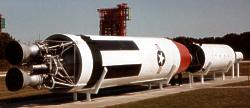Titan I Missile Overview

The Titan was the second Intercontinental Ballistic Missile (ICBM) of the USAF, the USAF's first multistage design, and the largest ICBM ever deployed by the United States.
In 1954, when development of the definite configuration of the SM-65 Atlas ICBM started, the USAF also awarded development contracts for alternative designs of many Atlas components, like engines, guidance system, and reentry vehicle. This was to prevent failure of the whole ICBM program in case a single component design didn't work. During 1955 it was finally decided to develop a complete second ICBM system as a full backup to Atlas. In October 1955, Martin was awarded a contract for airframe design and system integration for this "backup" ICBM, to be known as SM-68 Titan.
Martin chose not to use the fragile pressure stabilized airframe design of the Atlas, and therefore the whole structure was heavier, necessitating a two-stage design. Because Titan was a true backup, not intended for full-scale development and production unless Atlas would be significantly delayed, progress was slow until 1957. However, this changed in October that year after the Soviet Sputnik launch, and it was decided to deploy both Atlas and Titan by 1962. Testing of the SM-68 finally began in late 1958, and the first launch of an XSM-68 prototype (which had only a dummy second stage) succeeded in February 1959. Development problems (several XSM-68s exploded on the pad) delayed the first successful two-stage flight until January 1960. Titan testing continued through 1961, including launches from the silo-lift launcher of the operational missile. In April 1962, the first squadron of SM-68 Titan I missiles was declared operational.
The SM-68 was a two-stage liqued-fueled rocket-powered missile. The first stage used two Aerojet LR87-AJ-1 engines, and the second stage consisted of a single Aerojet LR91-AJ-1, with all engines burning kerosene (RP-1) and liquid oxygen. The SM-68 used a radio-command/inertial guidance after the originally planned all-inertial system had been transferred to the SM-65/CGM-16 Atlas. The SM-68 used the same Mk.4 reentry vehicle and W-38 warhead as the SM-65E/F Atlas E/F. The missiles were stored in widely dispersed hardended underground silos. After fueling, the Titan I had to be lifted out of the silo for launch. As with the Atlas, the non-storable liquid fuels were a safety hazard and also lead to a reaction time from order to launch of about 20 minutes. There was also am unarmed training version of the Titan I, designated USM-68A Titan Trainer.
When the much more advanced LGM-30 Minuteman and LGM-25C Titan II (see below) became operational in 1963, it was decided to phase out the Titan I (together with the Atlas) as quickly as possible. Between January and April 1965, all deployed Titan Is (54 missiles) were retired from service. Total production of the Titan I was about 160 missiles, of which more than 60 were launched for tests and training.
Manufacturer: Martin. Launches: 70. Failures: 17. Success Rate: 75.71%. First Launch Date: 1959-02-06. Last Launch Date: 1965-03-05. Launch data is: complete. Apogee: 1,000 km (600 mi). Associated Spacecraft: Avco Project 7969, Martin Project 7969. Liftoff Thrust: 1,295.900 kN (291,330 lbf). Total Mass: 105,142 kg (231,798 lb). Core Diameter: 3.05 m (10.00 ft). Total Length: 31.00 m (101.00 ft). Span: 3.05 m (10.00 ft). Maximum range: 11,300 km (7,000 mi). Number Standard Warheads: 1. Standard RV: Mk. 3. Standard warhead: W49. Standard warhead yield: 1,440 KT. Standard warhead CEP: 2.02 km (1.25 mi). Boost Propulsion: Liquid rocket, Lox/Kerosene. Guidance: Inertial. Maximum speed: 29,030 kph (18,030 mph). Ceiling: 1,287,800 m (4,225,000 ft). Development Cost $: 1,643.300 million. in: 1960 average dollars. Recurring Price $: 15.618 million. Total Number Built: 155. Total Development Built: 47. Total Production Built: 108. Flyaway Unit Cost $: 1.502 million. in: 1962 unit dollars.